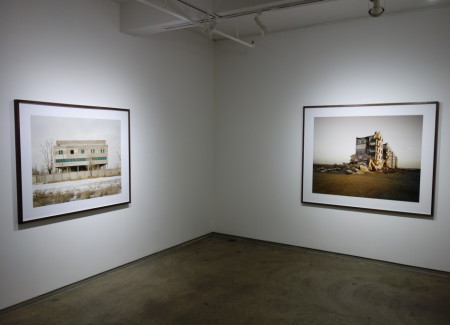JTF (just the facts): A total of 11 large scale color photographs, framed in black and unmatted, and hung against white walls in the three rooms of the main gallery space. All of the works are chromogenic prints, made in 2011. The prints are shown in three sizes: 38×48 (in editions of 5), roughly 48×59 (in editions of 5) and roughly 58×71 (in editions of 3). A monograph of this body of work was published in 2014 by Hatje Cantz (here). (Installation shots below.)
Comments/Context: Nadav Kander’s newest photographic project, Dust, is built on fundamental dissonance, in this case a classic artistic clash between content and aesthetics. It asks us to look closely at scenes of deliberate destruction and to take in the human logic that created them, and then to reconcile that ugliness with the beauty of tactile surfaces, warm golden light, and formal simplicity. The result is a set of pictures that never quite come to rest, oscillating back and forth between attraction and revulsion.
Kander’s images were taken in the former Soviet Union, in the secret “closed” cities of Kurchatov and Priozersk near the Aral Sea, in what is now Kazakhstan. These sites were used for covert testing of atomic bombs and other long range weapons during the years of the Cold War, their demolished remains now largely abandoned and decaying. In many cases, not only were various military technologies being evaluated, but the longer term effects of radiation on the unsuspecting local inhabitants and the surrounding environment were being watched and recorded. As a result, a pervading grimness hangs over these places, the traumas inflicted in these locations scarred over but not yet healed. A wide flat vista of the snowy steppe, with a graveyard running edge to edge and smokestacks in the distance, is a silent reminder of consequences that continue to resonate decades later.
Almost all of Kander’s photographs in this series document something akin to monuments, although few of the buildings and found objects were originally intended for such a purpose. Empty shells and fallen ruins of military housing, closed up telephone exchanges, and remnants of scientific research facilities stand like movie sets in the largely empty plains – facades with no supporting structures, hulking blocks with boarded up windows, and lonely fragments left standing amid piles of rubble. Fallen expanses of concrete huddle in the weeds, the upturned versions looming like ominous Easter Island monoliths or buried airplane tails watching over the rusty land. And isolated forms (a one-legged statue placed on a rocky outcropping, a rusty fishing trawler rotting in the sand, and a formerly heroic tulip monument with rockets shooting optimistically skyward) stand against the tides of inevitable decay, seemingly on the verge of collapse but still fighting to stay upright.
Kander’s photographs should be considered as a kind of bookend to a half century of atomic and nuclear age militarism – they fit into a continuum of photography that includes images from the aftermath of Hiroshima and Nagasaki, test sites in the American West, the disaster in Chernobyl, and somber monuments and war tragedies from across the globe. But while these photographs represent a version of evidence, they shouldn’t be mistaken for documentary pictures. Kander’s images are bathed in visual Romanticism, turning these desolate ruins into picturesque landscapes with broad skies and a muted palette of burnished colors. He has chosen to capture these places in poetic light, giving them an aesthetic elegance that competes with their undercurrents of violence. And since there are no people (survivors, victims, participants, bystanders, or otherwise) in Kander’s photographs, the psychology of his imagery is largely indirect, its horrors left to our imagination.
In the end, the disturbing loveliness of Kander’s pictures is darkly unnerving, in some cases, edging toward a feeling of emotional manipulation – we’re not supposed to find soothing beauty in such places. In giving history’s bleak lessons the patina of grace, he’s softened the emotional shock factor, choosing open ended nuance rather than directive lecturing as his mode of engagement. He’s given us symbolic forms, invisible ghosts, and scrubby grass, and left us to balance out the contradictions.
Collector’s POV: The works in this show are priced based on size. The 38×48 prints are $6000 each, the 48×59 prints are $10000 each, and the 58×71 prints are $15000 each. Kander’s work has begun to enter the secondary markets in the past few years. Recent prices have ranged between roughly $8000 and $25000.












